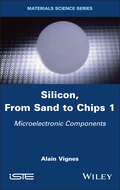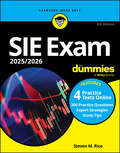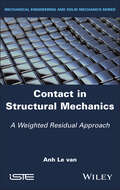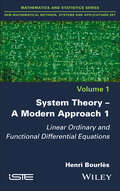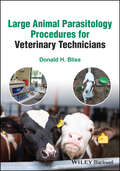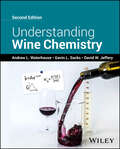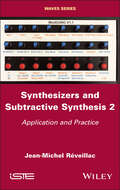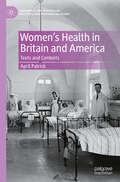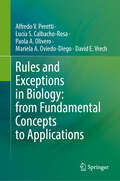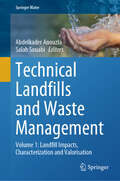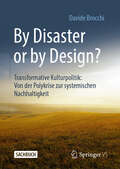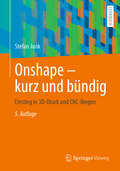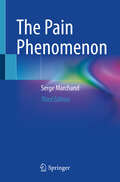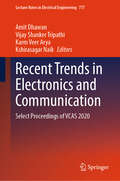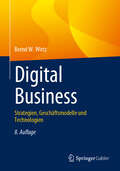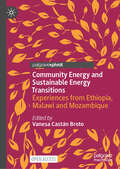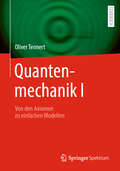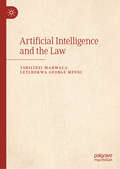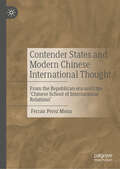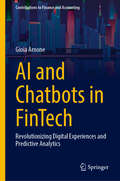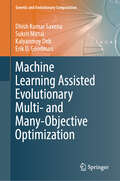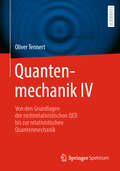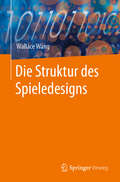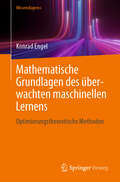- Table View
- List View
Silicon, From Sand to Chips, Volume 1: Microelectronic Components
by Alain VignesSilicon is the material of the digital revolution, of solar energy and of digital photography, which has revolutionized both astronomy and medical imaging. It is also the material of microelectromechanical systems (MEMS), indispensable components of smart objects. The discovery of the electronic and optoelectronic properties of germanium and silicon during the Second World War, followed by the invention of the transistor, ushered in the digital age. Although the first transistors were made from germanium, silicon eventually became the preferred material for these technologies. Silicon, From Sand to Chips 1 traces the history of the discoveries, inventions and developments in basic components and chips that these two materials enabled one after the other. The book is divided into two volumes and this first volume is devoted to basic microelectronic components.
SIE Exam 2025/2026 For Dummies: Securities Industry Essentials Exam Prep + Practice Tests + Flashcards Online
by Steven M. RiceSecure a great career in the financial securities industry with this SIE study guide The Securities Industry Essentials (SIE) Exam, administered by FINRA, is for aspiring securities industry professionals. Passing this exam is a prerequisite to the famous (and infamous) series-level exams such as the Series 7. SIE Exam 2025-2026 For Dummies is your one-stop study shop for the SIE exam. Test your knowledge with 4 practice tests, prep for test day, and get ready for the exam that will jumpstart your career. This book helps you lock in the key terms and concepts that you'll need to know to pass the SIE. It also teaches you how to apply them, so you can sail through test day and enter the securities industry with confidence. This revision contains more practice questions for each key content area, a new glossary of key terms, and online flashcards. Check the SIE exam off your to-do list with the help of this Dummies study guide. Study all the content you'll need to know to pass the SIE exam Practice with 4 full-length tests and flashcards available online Learn expert strategies for scoring your highest on the test Get started on your journey to a career as a financial securities professional This study guide is highly recommended for anyone looking to take the SIE exam in 2025 and beyond.
Contact in Structural Mechanics: A Weighted Residual Approach
by Anh Le vanContact in Structural Mechanics treats the problem of contact in the context of large deformations and the Coulomb friction law. The proposed formulation is based on a weak form that generalizes the classical principle of virtual powers in the sense that the weak form also encompasses all the contact laws. This formulation is thus a weighted residue method and has the advantage of being amenable to a standard finite element discretization. This book provides the reader with a detailed description of contact kinematics and the variation calculus of kinematic quantities, two essential subjects for any contact study. The numerical resolution is carried out in statics and dynamics. In both cases, the derivation of the contact tangent matrix – an essential ingredient for iterative calculation – is explained in detail. Several numerical examples are presented to illustrate the efficiency of the method.
System Theory -- A Modern Approach, Volume 1: Linear Ordinary and Functional Differential Equations
by Henri BourlèsThe theory of dynamic systems is addressed in this book in accordance with the “modern” approach, heir to algebraic analysis, which has been implemented since the last decade of the 20th century. After a reminder of the evolution of the representation of systems based on transfer functions or matrices, the duality of controllability and observability is revisited, and new results are produced concerning time-varying discrete-time systems. To complete and improve the existing analyses, the poles and zeros of linear systems and their interconnections are presented in a new way, as well as the problem of systems governed by functional differential equations (of retarded or neutral type) and their stabilization. This book also proposes known and original mathematical complements.
Large Animal Parasitology Procedures for Veterinary Technicians
by Donald H. BlissLarge Animal Parasitology Procedures for Veterinary Technicians Comprehensive illustrated reference on parasitic nematodes, cestodes, coccidian oocysts and trematode egg recoveries, identification, and enumeration with treatment strategies for five separate categories of animal patients Large Animal Parasitology Procedures for Veterinary Technicians illustrates, in detail, the most sensitive diagnostic procedure for internal parasites of domestic animals using the Modified Wisconsin Sugar Flotation Method. With step-by-step pictures and bullet-point instructions, this text discusses sample collection and storage techniques, as well as the strengths and weaknesses inherent to other commonly used tests. Potential sources for infection, the seasonality of the infection, possible environmental recontamination, and control strategies are all covered in detail, with suggestions to prevent reoccurrences. Parasites of the equine, large and small ruminants (including alpaca), swine, poultry and hoofed wildlife patients are included, with full color images for quick identification, an assessment of life cycle stage, and discussion of zoonotic potential. Each species section is heavily illustrated with comparative images to aid the technician in quickly identifying the parasite and life cycle stage. In Large Animal Parasitology Procedures for Veterinary Technicians, readers can find information on: The definition and economic importance of parasitisms, details on the epidemiology of parasitic enteritis, including basics of protozoology, helminthology, and overall applied veterinary parasitology Sample collection and shipment of specimens, including collection, storage, examinations, and interpretations Fecal examination using the Modified Wisconsin Sugar Flotation method, compared with gross examination, smear, sedimentation, and other flotation techniques, plus a fluke egg recovery technique and the Baermann technique for lungworm larvae recovery Internal parasite diagnosis and worm egg recoveries, descriptions and pictures of nematode parasite eggs (as well as coccidia oocysts), plus tapeworm eggs and fluke egg descriptions and photos for a variety of host animals Illustrating commonly used diagnostic tests in veterinary parasitology, with step-by-step instructions for accuracy, Large Animal Parasitology Procedures for Veterinary Technicians is an essential reference for veterinary technicians and veterinary technician students dealing with domestic animals, including horses, ruminants, swine, poultry, and hoofed wildlife.
Large Animal Parasitology Procedures for Veterinary Technicians
by Donald H. BlissLarge Animal Parasitology Procedures for Veterinary Technicians Comprehensive illustrated reference on parasitic nematodes, cestodes, coccidian oocysts and trematode egg recoveries, identification, and enumeration with treatment strategies for five separate categories of animal patients Large Animal Parasitology Procedures for Veterinary Technicians illustrates, in detail, the most sensitive diagnostic procedure for internal parasites of domestic animals using the Modified Wisconsin Sugar Flotation Method. With step-by-step pictures and bullet-point instructions, this text discusses sample collection and storage techniques, as well as the strengths and weaknesses inherent to other commonly used tests. Potential sources for infection, the seasonality of the infection, possible environmental recontamination, and control strategies are all covered in detail, with suggestions to prevent reoccurrences. Parasites of the equine, large and small ruminants (including alpaca), swine, poultry and hoofed wildlife patients are included, with full color images for quick identification, an assessment of life cycle stage, and discussion of zoonotic potential. Each species section is heavily illustrated with comparative images to aid the technician in quickly identifying the parasite and life cycle stage. In Large Animal Parasitology Procedures for Veterinary Technicians, readers can find information on: The definition and economic importance of parasitisms, details on the epidemiology of parasitic enteritis, including basics of protozoology, helminthology, and overall applied veterinary parasitology Sample collection and shipment of specimens, including collection, storage, examinations, and interpretations Fecal examination using the Modified Wisconsin Sugar Flotation method, compared with gross examination, smear, sedimentation, and other flotation techniques, plus a fluke egg recovery technique and the Baermann technique for lungworm larvae recovery Internal parasite diagnosis and worm egg recoveries, descriptions and pictures of nematode parasite eggs (as well as coccidia oocysts), plus tapeworm eggs and fluke egg descriptions and photos for a variety of host animals Illustrating commonly used diagnostic tests in veterinary parasitology, with step-by-step instructions for accuracy, Large Animal Parasitology Procedures for Veterinary Technicians is an essential reference for veterinary technicians and veterinary technician students dealing with domestic animals, including horses, ruminants, swine, poultry, and hoofed wildlife.
Understanding Wine Chemistry (Sci (society Of Chemical Industry) Ser.)
by Andrew L. Waterhouse Gavin L. Sacks David W. JefferyUnderstanding Wine Chemistry Understand the reactions behind the world’s most alluring beverages The immense variety of wines on the market is the product of multiple chemical processes – whether acting on components arising in the vineyard, during fermentation, or throughout storage. Winemaking decisions alter the chemistry of finished wines, affecting the flavor, color, stability, and other aspects of the final product. Knowledge of these chemical and biochemical processes is integral to the art and science of winemaking. Understanding Wine Chemistry has served as the definitive introduction to the chemical components of wine, their properties, and their reaction mechanisms. It equips the knowledgeable reader to interpret and predict the outcomes of physicochemical reactions involved with winemaking processes. Now updated to reflect recent research findings, most notably in relation to wine redox chemistry, along with new Special Topics chapters on emerging areas, it continues to set the standard in the subject. Readers of the second edition of Understanding Wine Chemistry will also find: Case studies throughout showing chemistry at work in creating different wine styles and avoiding common adverse chemical and sensory outcomes Detailed treatment of novel subjects like non-alcoholic wines, non-glass alternatives to wine packaging, synthetic wines, and more An authorial team with decades of combined experience in wine chemistry research and education Understanding Wine Chemistry is ideal for college and university students, winemakers at any stage in their practice, professionals in related fields such as suppliers or sommeliers, and chemists with an interest in wine.
Synthesizers and Subtractive Synthesis, Volume 2: Application and Practice
by Jean-Michel RéveillacSubtractive sound synthesis is one of the most widely used techniques in electronic music and in many analog synthesizers since the early 1960s. It is based on a simple principle, but its operation is complex, involving many parameters. It can be enhanced by a variety of effects that give the sound its authenticity, and does not simply imitate musical instruments, but can also transcribe noises present in natural soundscapes or generate entirely synthetic sounds. Synthesizers and Subtractive Sound Synthesis 2 presents practical exercises, ranging from the fundamentals to advanced functionalities. Most of the sound effects applicable to subtractive synthesis are covered: vibrato, phaser, reverb, etc. The final chapters deal with polyphony and arpeggiator-sequences.
Women's Health in Britain and America: Texts and Contexts (Humanities and Healthcare: Practical and Pedagogical Guides)
by April PatrickWomen’s Health in Britain and America: Texts and Contexts offers an unparalleled record of women’s health in the United Kingdom and the United States since 1750. Through chapters on pregnancy and childbirth, contraception and abortion, and breast and gynecological cancers, today’s readers can better understand historical precedents for contemporary issues. Introductory overviews present context about the history of medical care for women, such as diagnosis and treatment of specific conditions, medical advances, social and political contexts, and the effects of these on their lived experiences. The book presents a collection of primary texts including archival memoirs, letters, and diaries as well as published fiction, poetry, and medical advice. Women’s Health in Britain and America provides the necessary background for those new to the subject while also offering unique texts that will engage those already immersed in the field. As the political and social discussions around women’s bodies become more contentious and consequential, the history and the multiplicity of voices presented on these pages are more important than ever.
Rules and Exceptions in Biology: from Fundamental Concepts to Applications
by Alfredo V. Peretti Lucía S. Calbacho-Rosa Paola A. Olivero Mariela A. Oviedo-Diego David E. VrechThis is the first book to cover and explore the rules and exceptions in biology. It presents past and current perspectives on the subject and discusses the various situations of transition from rule to exception and vice versa. In doing so, the book fills a gap in the scientific literature and stimulates useful and valuable discussions among researchers working in biology worldwide. The chapters begin with a theoretical framework, followed by the main topic(s) or question(s), and a summary of previous work on the topic. Examples are discussed, with concluding remarks and suggestions for future research. A section with key concepts is included at the end of each chapter, allowing the reader to jump directly to the most important findings or observations. Each chapter is written to be used as a reference by graduate students and professionals from a variety of scientific disciplines (e.g. behavior, ecology, evolution, and systematics).
Technical Landfills and Waste Management: Volume 1: Landfill Impacts, Characterization and Valorisation (Springer Water)
by Abdelkader Anouzla Salah SouabiA "zero waste" society and the "circular economy" trend are urgently needed. Even if achieving 100% trash recycling and a fully circular economy may not always be attainable, aiming toward this goal might result in a sustainable future. Municipal solid wastes pose a hazard to the environment because of open burning, landfills, reckless disposal, and many other factors. Waste is being thrown away in more significant quantities and is made up of several different materials. Municipal solid waste (MSW) characteristics must be carefully considered when developing, implementing, or modifying solid waste management systems. Local waste variables that vary with cultural, climatic, socioeconomic, and institutional capacities are crucial for developing efficient waste management techniques. This book provides a comprehensive overview of landfills' situation, their categories, and the types of garbage they receive. The final section of the study provides an overview of prospective waste management techniques, their restrictions, and the potential areas for further research on landfill sites. This book has the advantage that world-class experts in their respective fields have written each chapter. As a result, this book presents a balanced picture across the whole spectrum of chapters on municipal solid wastes.
By Disaster or by Design?: Transformative Kulturpolitik: Von der Polykrise zur systemischen Nachhaltigkeit
by Davide BrocchiJede große Transformation in der Geschichte der Menschheit wurde bisher von einer kulturellen Revolution ausgelöst und begleitet. Diese Publikation zeigt, warum dies auch für die Transformation zur Nachhaltigkeit gilt. Im Fokus stehen nicht nur Werte, Menschen- und Naturbilder, sondern auch die gesellschaftliche Verantwortung von Bildung, Wissenschaft, Kunst und Medien. Für die zweite Auflage wurden die Inhalte überarbeitet und aktualisiert, Thesen geschärft und neue Studien einbezogen.Gegenwärtig befinden wir uns zwischen zwei großen gesellschaftlichen Transformationen: Die erste ist die kapitalistisch-industrielle, die vor fünf Jahrhunderten begann, bis heute dominiert und sich am Kulturprogramm der Modernisierung orientiert. Sie hat die Gesellschaft in eine Polykrise geführt, es droht ein Zivilisationskollaps. Die zweite Transformation ist jene zur Nachhaltigkeit, die sich an „Visionen einer anderen Entwicklung“ jenseits von Wachstum und Massenkonsum orientiert. Diese beiden Transformationen verdrängen sich an einigen Stellen gegenseitig und vermischen sich an anderen. Einerseits ist es die schwächere Transformation, die oft assimiliert wird. So werden derzeit eine „ökologische Modernisierung“ und ein „nachhaltiges Wachstum“ theorisiert, obwohl solche Ansätze Widersprüche an sich sind. Andererseits ist die soziale und ökologische Umwelt ein politisches Subjekt, das immer stärker in Dynamiken und Debatten mitmischt. So oder so wird sich an den Reibungsflächen zwischen den beiden Transformationen entscheiden, wie sich die Transformation zur Nachhaltigkeit am Ende durchsetzt: by Disaster or by Design.
Onshape - kurz und bündig: Einstieg in 3D-Druck und CNC-Biegen
by Stefan JunkDieses Lehrbuch ermöglicht Anfängern in der 3D-Modellierung einen schnellen Einstieg in die Arbeit mit dem cloudbasierten praxisorientierten CAD-System Onshape. Dabei werden bei jedem Schritt die besonderen Anforderungen an eine 3D-Druck-gerechte Gestaltung erläutert und umgesetzt. Das Ergebnis dieser „Schritt für Schritt“-Anleitung ist die vollständige Modellierung eines Miniatur-Automobils, das am 3D-Drucker in ein reales Modell umgesetzt werden kann. Die vorliegende Auflage enthält nun eine Übersicht der 3D-Druckwerkstoffe und geht auf die aktuellen Weiterentwicklungen von Onshape ein. Neue Funktionen, wie die Erstellung von Stücklisten, Explosionsansichten und Schnittansichten, werden demonstriert.
The Pain Phenomenon
by Serge MarchandIntroducing the latest edition of The Phenomenon of Pain: A Comprehensive Exploration of Pain Mechanisms and Therapeutic Approaches.In recent decades, pain has emerged as a focal point in both basic and clinical research, reflecting its profound impact on individuals' lives. The rapid advancement of knowledge has deepened our understanding of the complex neurophysiological and psychological mechanisms underlying pain, shedding light on its multifaceted nature. Clinicians grapple daily with the daunting reality of human suffering, navigating its intricate web of causes and manifestations. This continuous engagement with pain presents significant and stressful challenges from the relentless pursuit of understanding and alleviating it. This book transcends mere discourse on the physiological and psychological underpinnings of pain; it delves into the intricate factors contributing to its persistence. Furthermore, it meticulously examines pharmacological and nonpharmacological treatment modalities, forging a crucial link between the mechanisms of pain and therapeutic interventions.By bridging the gap between pain mechanisms and treatment strategies, this edition equips clinicians with invaluable insights to augment their clinical acumen. Armed with this knowledge, clinicians can tailor interventions to effectively address the diverse array of pain presentations encountered in their practice.
Recent Trends in Electronics and Communication: Select Proceedings of VCAS 2020 (Lecture Notes in Electrical Engineering #777)
by Amit Dhawan Vijay Shanker Tripathi Karm Veer Arya Kshirasagar NaikThis book comprises select proceedings of the International Conference on VLSI, Communication and Signal processing (VCAS 2020). The contents are broadly divided into three topics – VLSI, Communication, and Signal Processing. The book focuses on the latest innovations, trends, and challenges encountered in the different areas of electronics and communication, especially in the area of microelectronics and VLSI design, communication systems and networks, and image and signal processing. It also offers potential solutions and provides an insight into various emerging areas such as Internet of Things (IoT), System on a Chip (SoC), Sensor Networks, underwater and underground communication networks etc. This book will be useful for academicians and professionals alike.
Digital Business: Strategien, Geschäftsmodelle und Technologien
by Bernd W. WirtzDigital Business ist ein wesentlicher Erfolgs- und Wettbewerbsfaktor für Unternehmen. Das Buch behandelt umfassend die Grundlagen, Strategien, Geschäftsmodelle und Entwicklungsmöglichkeiten. Neben operativen Managementthemen werden neu in der 8. Auflage auch die digitale Transformation, die digitale Automatisierung und Robotik, Ansätze der Künstlichen Intelligenz und das Quantum Computing thematisiert.
Community Energy and Sustainable Energy Transitions: Experiences from Ethiopia, Malawi and Mozambique
by Vanesa Castán BrotoThis open access book engages with the difficulties of delivering community energy in practice, building on practical experiences in Ethiopia, Malawi, and Mozambique. In these countries, where many people lack access to electricity, community energy is an alternative to advance universal energy access. This book argues that, besides providing access, community energy is essential for achieving justice and resilience in sustainable energy transitions. Community energy combines off-grid infrastructures with innovative forms of governance to incorporate the perspectives of beneficiaries in the generation and distribution of electricity. Community energy has multiple benefits for communities, such as facilitating the adoption of renewable technologies, providing energy access where it is lacking, and building resilience. They also offer societal benefits beyond beneficiary communities, such as providing additional capacity to existing grids, delivering off-grid services where the grid is absent, and bridging on-grid and off-grid systems. Despite its promises, however, the adoption of community energy has been slow. This book presents a feminist-informed perspective on community energy to advance energy justice that puts disadvantaged communities at the centre of sustainable energy transitions. It also explores the room for manoeuvre within existing regulatory systems, supply chains, and delivery systems to facilitate its development. By engaging with existing experiences in community energy, the book demonstrates the potential of communities to gain control over their energy needs and resources and argues for the need to develop a wide range of transdisciplinary skills among policymakers, technicians and communities to deliver a just energy transition.
Quantenmechanik I: Von den Axiomen zu einfachen Modellen
by Oliver TennertIn einer umfassenden Darstellung entwickeln und vertiefen die vier Bände dieses Lehrbuchs das Gebäude der nichtrelativistischen Quantenmechanik, weshalb sie auch bestens als Nachschlagewerk geeignet sind. Der erste Band beginnt mit einer anekdotenreichen und spannenden historischen Überblicksdarstellung, die die Hauptprotagonisten der Quantentheorie und wichtige Meilensteine ihres Wirkens vorstellt. Im Folgenden wird dann die Formulierung im Hilbert-Raum axiomatisch entwickelt und wichtige Grundlagenthemen behandelt: die eindimensionalen Probleme, der harmonische Oszillator und die WKB-Näherung als Bindeglied zur klassischen Physik. Besonderheiten: Auch komplizierte Zusammenhänge werden illustrativ und klar erklärt. Zahlreiche mathematische Einschübe erläutern allgemeine mathematische Zusammenhänge. Besondere Highlights des Buches sind die frühe Entwicklung von Propagatormethoden, die ausführliche mathematische Behandlung von kohärenten und gequetschten Zuständen des harmonischen Oszillators, sowie die gründliche Untersuchung des klassischen Grenzfalls. Inhalt 1. Historischer Abriss: Der Weg zur Quantenmechanik - 2. Der theoretische Formalismus der Quantenmechanik - 3. Eindimensionale Probleme - 4. Der harmonische Oszillator in der Quantenmechanik - 5. Die WKB-Näherung und der klassische Grenzfall Zielgruppe: Das Buch richtet sich sowohl an Bachelor- als auch an Masterstudierende sowie ihre Lehrenden. Aufgrund seines mehrbändigen Charakters, der breiten Themenvielfalt und Bezügen zu wissenschaftlichen Originalarbeiten allerdings ein Muss für jedes Bücherregal einer in der Physik tätigen Person. Vorkenntnisse: Vorausgesetzt werden Kenntnisse der Theoretischen Mechanik, der Elektrodynamik und der Speziellen Relativitätstheorie, sowie der Analysis, der linearen Algebra und der Funktionentheorie.
Artificial Intelligence and the Law
by Tshilidzi Marwala Letlhokwa George MpediThis textbook offers a starting point for the education of attorneys and other legal professionals about the potential impact of artificial intelligence (AI) on the law, as well as a forum for discussing artificial intelligence's legal and ethical concerns. Intended for classroom use, this book will help students, legal professionals and policymakers alike. AI is swiftly transforming the world, including the legal system. Legal applications to areas such as ethics, human rights, climate change, labor law, health, social protection, inequality, lethal autonomous weapons, the criminal justice system and autonomous vehicles, contract drafting, legal investigation, criminal analysis and evidence investigation, utilize AI. As AI becomes more sophisticated, its impact on the law will likely increase.
Contender States and Modern Chinese International Thought: From the Republican era until the ‘Chinese School of International Relations’
by Ferran Perez MenaThis book contends that the development of modern Chinese international thought has been profoundly shaped by the distinctive nature of the Chinese state as a contender state and its global positioning since 1912. The argument posited demonstrates that, notwithstanding the varied perspectives on the 'international' held by Chinese intellectuals throughout the 20th century, there exist commonalities across the periods analyzed in this book. In essence, the book emphasizes that the shared elements influencing the production of modern Chinese international thought do not derive from a unified cultural Chinese identity but rather stem from China's evolving geopolitical position in the modern world.
AI and Chatbots in Fintech: Revolutionizing Digital Experiences and Predictive Analytics (Contributions to Finance and Accounting)
by Gioia ArnoneThis book is a comprehensive guide to the use of Artificial Intelligence (AI) in the Financial Technology (FinTech) industry. It is comprised of ten chapters, each addressing a specific aspect of AI in FinTech. The reader is introduced to AI in FinTech, including its history and current state and the role of chatbots in FinTech and how they are used to improve customer service. Furthermore, the book explores the business framework of AI-based ChatGPT in FinTech, including the technology behind ChatGPT and how it can be applied to various financial sectors. The book examines the use of predictive analytics and machine learning in FinTech, highlighting how these tools are used to predict customer behavior and improve decision-making. The author delves into how ChatGPT is used to determine buying behavior and discusses the use of machine learning to reshape the digital experience in FinTech. Additionally, the book provides best practices for retaining customers in FinTech, including how to use AI to create personalized experiences that keep customers coming back, and explores the different applications of predictive models in FinTech, including how they are used to improve risk management and fraud detection. Lastly, the book discusses the use of ChatGPT for stock price prediction and the detection of financial fraud and examines the role of ChatGPT in the world of cryptocurrency, including how it can be used to make informed investment decisions. Overall, this book provides a comprehensive overview of the different ways AI is being used in FinTech and the potential it holds for improving customer experiences and driving innovation in the financial industry.
Machine Learning Assisted Evolutionary Multi- and Many- Objective Optimization (Genetic and Evolutionary Computation)
by Dhish Kumar Saxena Sukrit Mittal Kalyanmoy Deb Erik D. GoodmanThis book focuses on machine learning (ML) assisted evolutionary multi- and many-objective optimization (EMâO). EMâO algorithms, namely EMâOAs, iteratively evolve a set of solutions towards a good Pareto Front approximation. The availability of multiple solution sets over successive generations makes EMâOAs amenable to application of ML for different pursuits. Recognizing the immense potential for ML-based enhancements in the EMâO domain, this book intends to serve as an exclusive resource for both domain novices and the experienced researchers and practitioners. To achieve this goal, the book first covers the foundations of optimization, including problem and algorithm types. Then, well-structured chapters present some of the key studies on ML-based enhancements in the EMâO domain, systematically addressing important aspects. These include learning to understand the problem structure, converge better, diversify better, simultaneously converge and diversify better, and analyze the Pareto Front. In doing so, this book broadly summarizes the literature, beginning with foundational work on innovization (2003) and objective reduction (2006), and extending to the most recently proposed innovized progress operators (2021-23). It also highlights the utility of ML interventions in the search, post-optimality, and decision-making phases pertaining to the use of EMâOAs. Finally, this book shares insightful perspectives on the future potential for ML based enhancements in the EMâOA domain.To aid readers, the book includes working codes for the developed algorithms. This book will not only strengthen this emergent theme but also encourage ML researchers to develop more efficient and scalable methods that cater to the requirements of the EMâOA domain. It serves as an inspiration for further research and applications at the synergistic intersection of EMâOA and ML domains.
Quantenmechanik IV: Von den Grundlagen der nichtrelativistischen QED bis zur relativistischen Quantenmechanik
by Oliver TennertIn einer umfassenden Darstellung entwickeln und vertiefen die vier Bände dieses Lehrbuchs das Gebäude der nichtrelativistischen Quantenmechanik, weshalb sie auch bestens als Nachschlagewerk geeignet sind. Der vierte Band beginnt mit einem ausführlichen Kapitel zur nichtrelativistischen Quantenelektrodynamik (QED), traditionell als "Quantentheorie der Strahlung" bezeichnet, und leitet dann über in die relativistische Quantentheorie. Eine sorgfältige Behandlung der Möglichkeiten und Grenzen einer relativistischen Quantenmechanik sowie eine gründliche Untersuchung von Symmetrien in der relativistischen Quantentheorie schließen das Lehrbuch ab. Besonderheiten: Auch komplizierte Zusammenhänge werden illustrativ und klar erklärt. Zahlreiche mathematische Einschübe erläutern allgemeine mathematische Zusammenhänge. Besondere Highlights des Buches sind eine ausführliche Diskussionder Lamb-Verschiebung und des Casimir-Effekts, einschließlich der in diesem Zusammenhang offenbar werdenden Problematik der Renormierung, sowie die Analyse der Einteilchen-Interpretation in der relativistischen Quantenmechanik und die Betrachtung von Gruppenkontraktionen im Übergang von relativistischen zu nichtrelativistischen Symmetriegruppen und ihrer Darstellungen. Inhalt 1. Quantisierung des elektromagnetischen Feldes - 2. Relativistische Quantenmechanik - 3. Symmetrien in der Quantenmechanik II Zielgruppe: Das Buch richtet sich sowohl an Bachelor- als auch an Masterstudierende sowie ihre Lehrenden. Aufgrund seines mehrbändigen Charakters, der breiten Themenvielfalt und Bezügen zu wissenschaftlichen Originalarbeiten allerdings ein Muss für jedes Bücherregal einer in der Physik tätigen Person. Vorkenntnisse: Vorausgesetzt werden Kenntnisse der Theoretischen Mechanik, der Elektrodynamik und der Speziellen Relativitätstheorie, sowie der Analysis, der linearen Algebra und der Funktionentheorie.
Die Struktur des Spieledesigns
by Wallace WangDie Struktur des Spieledesigns soll angehenden und erfahrenen Spieleentwicklern helfen, ihre Ideen in funktionierende Spiele umzusetzen. Die Erstellung eines Spiels erfordert das Verständnis der grundlegenden Elemente aller Arten von Spielen, angefangen von papierbasierten Spielen bis hin zu den neuesten Videospielen. Durch das Verständnis, wie diese grundlegenden Prinzipien in allen Arten von Spielen funktionieren, können Sie dieselben Prinzipien anwenden, um Ihr eigenes Spiel zu entwerfen.Spiele handeln von Zielen, Struktur, Spiel und Spaß. Während jeder seine eigene Vorstellung davon haben wird, was "Spaß" sein könnte, kann jeder Spieleentwickler die Freude der Spieler maximieren, indem er bedeutungsvolle Entscheidungen anbietet, die verschiedene Risiken und Belohnungen mit sich bringen. Solche Herausforderungen, kombiniert mit Regeln und Einschränkungen, zwingen die Spieler, Hindernisse und Probleme mit verschiedenen Fähigkeiten wie Geschicklichkeit, Rätsellösung,Intelligenz und Strategie zu überwinden. Im Wesentlichen ermöglichen Spiele den Spielern, in neuen Welten voranzukommen und Probleme in einer sicheren, aber aufregenden Umgebung zu überwinden, die es ihnen ermöglicht, am Ende zu triumphieren.Genau wie das Spielen von Spielen weltweit bei allen Altersgruppen, Geschlechtern und Kulturen beliebt ist, erfreut sich auch das Game Design gleichermaßen großer Beliebtheit. Spiele können die Spieler herausfordern, den besten Zug zu machen, Rätsel zu lösen, sich im Kampf zu engagieren, Ressourcen zu verwalten und Geschichten zu erzählen. Indem man versteht, wie Zufall, Psychologie und Balance die Art und Weise beeinflussen können, wie Spiele gespielt werden, können die Leser entscheiden, welche Spielelemente am besten für ihre eigene Spielkreation geeignet sind.Ob Ihr Ziel darin besteht, Geld zu verdienen, etwas Neues zu lernen, eine soziale Aussage zu machen, eine bestehende Spielidee zu verbessern oder Ihre künstlerischen, programmierenden oder gestalterischen Fähigkeiten zu testen, kann das Game Design genauso viel Spaß machen wie das Spielen von Spielen. Indem Sie die Teile eines Spiels kennen, wie sie funktionieren, wie sie interagieren und warum sie Spaß machen, können Sie Ihr Wissen nutzen, um jede Idee in ein Spiel zu verwandeln, das andere spielen und genießen können.
Mathematische Grundlagen des überwachten maschinellen Lernens: Optimierungstheoretische Methoden
by Konrad EngelDieses Buch behandelt die gängigsten Methoden zur Klassifikation von digitalisierten Objekten. Jedem Objekt ist ein Punkt im Euklidischen Raum passender Dimension zugeordnet. Das Lernen basiert auf einer Menge von Punkten, für die die zugehörige Klasse bekannt ist. Eine Reduktion der Dimension sowie elementare und anspruchsvollere Methoden zur Ermittlung schnell berechenbarer Funktionen, mit denen man aus einem Punkt die zugehörige Klasse mit einer möglichst geringen Fehlerrate ableiten kann, werden hergeleitet und in einer einheitlichen Herangehensweise begründet. Die recht elementaren Beweise werden im Wesentlichen mit Mitteln der Linearen Algebra geführt, nur für die neuronalen Netze wird etwas Analysis benötigt.Die Produktfamilie WissensExpress bietet Ihnen Lehr- und Lernbücher in kompakter Form. Die Bücher liefern schnell und verständlich fundiertes Wissen.
